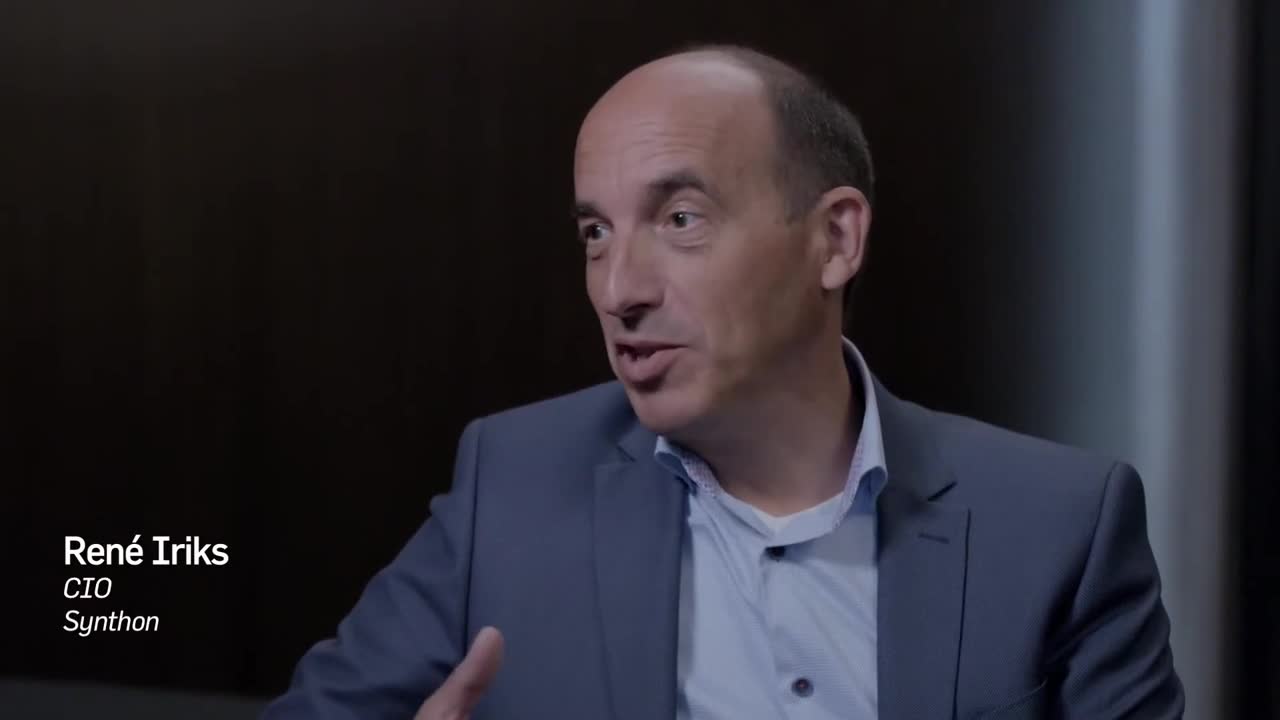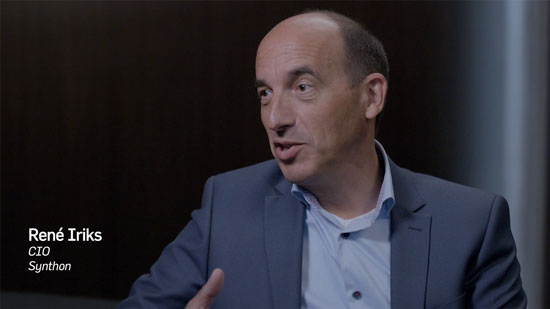Table of contents
Key Takeaways
- The major ERP systems cover as little as 20% of the end-to-end supply chain.
- IT is looking for business guidance to develop strategy and roadmap and to steer the business away from “rogue” solutions.
- Building trust between the business and IT is a daily effort, but essential to ensure the best possible solution.

Synthon CIO René Iriks describes how IT can become a long-term partner of supply chain operations to ensure that digitalization and data-driven solutions meet the needs of the business and provide a foundation for continued innovation.
Transcript:
Roddy Martin: René, welcome back to another discussion. It's really good to have a CIO to have a heart‑to‑heart supply chain discussion with. Let's understand a little bit about your background, and then we can talk about the CIO role and the supply chain.
René Iriks: All right. I joined the company I'm working for, Synthon, about 18 years ago. During those 18 years, I gained a lot of pharmaceutical knowledge, not only in supply chain, but also, in the R&D area, and also in the manufacturing area.
That gives me a lot of, I think, overall knowledge about the total, of the overall process. I think that, for me, it's really interesting, because it makes me deep dive in all those different areas and talk with the business people about potential improvements from an IT perspective.
Roddy: As I said to you, some of the best supply chain leaders that I know have been CIOs or have led parts of IT in the past. I think it helps a business really understand what's possible and what's just a pie in the sky.
As a non‑savvy supply chain leader, I can ask you for anything and expect you to deliver anything. Talk a little bit about a day in the life as René, as you are a CEO, talking to supply chain people. What's different? What do you pay special attention to as you talk to supply chain people?
René: It actually is what I need. The way we do business, we are a business‑to‑business organization. Only a fraction, we do business‑to‑consumer. Mainly, we are business‑to‑business. It's all about supply and demand.
We have customers demanding products, and we need to supply them in the most efficient way. That means that we need to have a reliable forecast. It all starts with a reliable forecast. From that moment on, we need to start to, let's say, buy the starting materials and things manufactured.
Eventually, we need to produce the goods for the customer. When we talk to the supply chain people, they are always extremely busy, because they are always under a lot of pressure.
Roddy: Managing someone who has a crisis?
René: Yes. It's always crisis, because they are always under pressure. Goods coming in late, pressure from our customers to have goods delivered. They are always under extreme pressure. The information they need to have to do their job in the perfect way, in the best way, is essential to them.
It is, for me, my responsibility to be able to deliver the information they require on a daily basis. Again, it's a combined effort between the people from the business and IT. We need to deliver the right systems, the right configured systems.
They need to have a reliable forecast, again. That's also very important. It's a mix of different groups of people working together to get things done in the most efficient way.
Roddy: That's interesting. I imagine that sometimes, supply chain would be a little testy, because they expect IT to just kick its heels, just go out, and deliver. Whereas you would have a solid ground to push back and say, "Hold on a moment. That's not the right way to do this." They would listen to you?
René: I think a huge benefit for me is that I am not a supply chain guy. I am allowed to ask stupid questions. When supply chain people come to me, and they already have a proposal, they already have a solution in‑place.
They do not ask me for their help. They ask me to provide a solution, because they already thought about the process and about the solution so much, they know exactly what you want. Still, it's the game you play.
I start asking stupid questions. Why do you want to have it like this? Can we not do it in a different way? Can we not look at it from another angle? That is interesting in that conversation, although to me, it seems to be like...
Roddy: Basic, right?
René: ...basic questions. Then often, they get, let's say, triggered. Say, "OK, hmm. Oh, we actually never looked at it from that perspective." That is really interesting for the conversation, is how are we eventually going to build the solution which will help them in getting their job done?
That is, for me, the really interesting part. In my position, I would say, I am allowed to ask stupid questions, which at the end, it brings some benefit from all of us.
Roddy: One of the things that is good being in that role is there is a propensity sometimes from supply chain to go and build things yourself, but just keep it under the radar screen. "We won't tell IT." You're going to find out, because you have so much of a better understanding about supply chain, that you will uncover some of these rogue projects.
Whilst supply chain may think at the time it's a great idea to do that, it becomes one of those wisdom teeth that no one ever wants to pull out, because they built it. It's their little pet project. How do you deal with that?
Do you have a lot of that, or have you got the governance to a point where it doesn't happen that often?
René: I would say, with the ease that people can just go online and purchase any solution they like...They are out there. Everything is in the cloud. You use your credit card, you subscribe to any solution, and you start using it.
Whether we want it or not, people can do it. That's how the world today works. To avoid that, and to some extent, you would say, "Do you need to avoid it?" I think you always need to give them some freedom to maneuver, because they're also quite intelligent people, do not forget.
I think it mainly comes down to one word, and that's trust. When there is an established level of trust between the business and IT, I think we can find each other somewhere in the middle and work from that point onwards to, let's say, the best solution for both parties.
If there is no trust, then easily, departments will choose solutions, whatever they think is best.
Roddy: To hide things.
René: Maybe not benefiting the company as a whole. At least for them, it's an easy fix, an easy solution. I think that is often wrong, where IT and the business are totally disconnected. Building trust is not easy.
It requires a daily effort, because at the one hand, you need to challenge them, but also, you need to gain knowledge about how they operate. You need to know what is on top of their minds, what are their concerns, and is also maybe the business model changing?
Either way the dynamics, for example, if you have business‑to‑business or business‑to‑consumer, are totally different. On the one hand, I talk to organizations, or to departments within my organization that do business‑to‑business.
The dynamics are much different when I go to other departments which does business‑to‑consumer. You also need to understand those differences, and they have also, then, in that sense, different needs.
Roddy: When you talk about trust and transparency, that's what it's all about. It's not seeing what you can get away with.
René: No.
Roddy: It's being open and trusting. Sure, if that doesn't work, then there's ways of addressing that, but you can't start off by not trusting.
René: Right. You can start cutting corners and stuff like that to get done quickly, in an easy way, with a low cost. Eventually, you will get confronted with the issue, maybe a few years later. That is, I think, if you are committed to work for the company for a long time, you're also committed to provide good solutions for the long term.
Instead of making quick fixes, I say, "OK, I will have somebody else taking care of the mess after a few years," no, it is my mess. I have to deal with it. That means that I need to have the proper solutions from the first moment onwards.
Roddy: I used to hate the expression, "It's a throwaway solution." There's no such thing as the throwaway solution. Something you put in for two years and say, "Well, when we get to the end of the two years, we'll throw it away, and we'll start with something else."
Then the business becomes so used to using it, it is so painful to get that thing out and throw it away. It's unpleasant.
René: Before you know it, you will start using it for five, six, seven, eight years. If you don't do it right from the start, you will face problems for the coming eight years.
Roddy: That's one thing I have seen about the pharmaceutical industry. That is, "We're so different that we have to build our solutions." I sometimes wonder, do they think they're a software company, especially in the IT organization, or are they a supply chain and a pharmaceutical company?
I think that that's where leadership has to be strong. A strong leader like you can say, "Look, this is stupid to try and build this ourselves. There are solutions that we can get out in the market."
René: If you look at supply chain nowadays, people would say, "Supply chain is covered by our ERP system." If you look at the ERP system, every example ERP system you have available nowadays. I think there are only a few big players.
If you look at the amount of support they are getting towards the supply chain, it's quite limited. They only control maybe 20 percent of the whole chain. What happens, then, to the other 80 percent? Do we need no information about that, or do we not need to be in control?
I think there is a huge opportunity for software vendors like TraceLink to step in that unexplained area, where they can provide a lot of additional value for companies.
Roddy: It's a better holistic solution, understanding the interdependencies. I think that's another point I would make about the strength of having a CIO who really understands the business and supply chain operations. You know what the interdependencies are.
René: If we want to get our deliveries, let's say, up to 95 percent, you could do different things. You could say, "OK, I will increase my stock levels to the absolute maximum, so I will always be able to deliver my goods on‑time."
Then the financial people will start complaining and say, "Look, my stock's go through the roof." From a financial perspective, that is not really healthy. You need to find a balance. You want to have these deliveries set to a higher standard.
On the other hand, you want to minimize your financial waste. It means that you need to look at all the aspects and to say, "OK," together with the supply chain people, "How can we optimize?" Also, with the salespeople, "How can we optimize the whole chain to get the best, at least for our customers, and eventually, also for ourselves?"
It is not, like you said, that if you tweak a little bit left, then automatically, on the right side, it will be done great. No, you have to manage it.
Roddy: It's a very difficult space with the amount of technology change that's going on. It must be very frustrating for a supply chain leader not to have a CIO who doesn't understand the fundamentals of the business and treats this as a technology. It's not technology. It's about enabling the business.
René: Right, it's all about technology. Technology, at the end, helps us get things done. First is the business side, the process side. That has to be done correctly. Then eventually, we will bring in some IT solutions that will provide whatever we want. That's how it should be.
As Chief Digital Strategist at TraceLink, Roddy Martin is responsible for guiding TraceLink’s business transformation initiatives through his expertise and insight into change management and end-to-end digital supply chain strategy.
Return to: The Patient-Driven Supply Network






